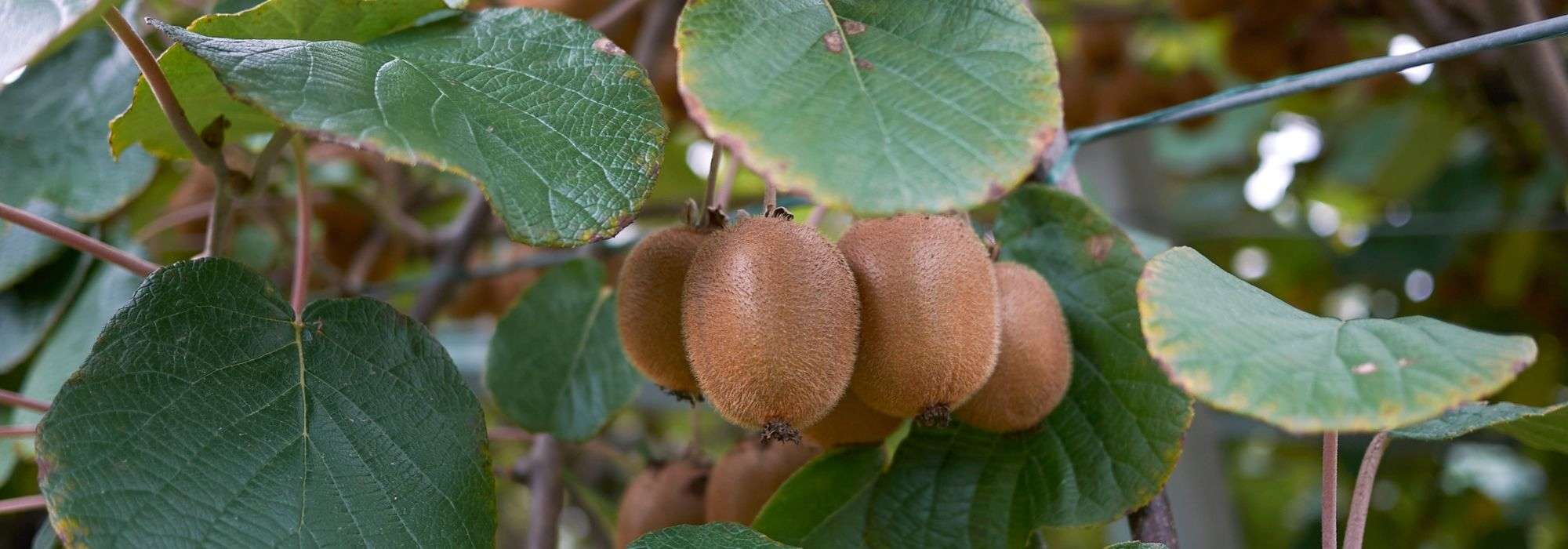
Actinidia, Kiwi tree: planting, pruning, harvesting
Contents
Actinidia in a nutshell
- Actinidia or kiwi tree is a fruiting liana that bears kiwi, one of the most widely cultivated fruits in the world
- It produces tasty fruits with green, yellow, or purple flesh depending on the variety
- Generally, you need to wait 4 to 5 years before harvesting your first kiwis
- If you do not choose a self-fertile variety, you will need one male plant and one female plant to obtain fruit
- Very hardy, actinidia can be trained along a pergola, trellis, or arbour
A word from our expert
The Kiwi, Chinese Gooseberry or Kiwi Tree is a hardy liana that produces one of the most cultivated fruits in France and worldwide: the kiwi. Imported from New Zealand, this Chinese liana grows very well in our latitudes, contrary to popular belief. Provided that the secrets of pollination are respected!
While today there are some self-fertile varieties of Actinidia such as Actinidia chinensis ‘Solissimo®’, most often you will need to plant a male plant near a female plant to obtain fruit. From Actinidia chinensis or deliciosa to Actinidia arguta, also known as Kiwi, these mini-kiwis with smooth skin, along with Actinidia kolomikta, encompass numerous varieties, offering fruits with different shapes and flavours.
Its fruits, known for their many benefits, lend themselves to various recipes, from compotes to juices or jams!
It grows very well here once properly established in cool, low-calcium, well-drained soil and correctly trained.
How can you recognise a male and female kiwi tree? How do you prune an Actinidia? Discover how to grow the kiwi tree and enjoy beautiful fruits throughout the seasons!
Description and botany
Botanical data
- Latin name Actinidia
- Family Actinidiaceae
- Common name Kiwi, Kiwai
- Flowering May-June
- Height 5 to 10 m
- Exposure Sun, partial shade
- Soil type rich and light
- Hardiness -15°C
The Kiwi (Actinidia chinensis or deliciosa), also known as the kiwifruit, Chinese gooseberry, or “vegetable mouse,” is a climbing fruit bush belonging to the Actinidiaceae family, just like its cousin the Kiwai or Siberian Kiwi (Actinidia arguta), which produces smooth-skinned fruits.
The kiwi originates from the temperate regions of China, not New Zealand, which remains its primary exporting country. The kiwi arrived in France, in Nice, in 1904, and has since acclimatised widely, mainly in the Landes, the Midi, and Corsica.
There are about 30 species of kiwi, but only 5 produce edible fruits and are cultivated for this purpose in France. Among them, Actinidia deliciosa, whose fruits have a fuzzy skin, and its many cultivars, some of which are self-fertile, such as ‘Jenny’ or ‘Solo’, the most well-known. The species Actinidia chinensis offers kiwis with smooth skin, while Kiwi arguta, also known as “Kiwai,” produces smaller fruits than traditional kiwis that can be eaten with the skin.
This vigorous, woody climbing liana clings to any support with its tendrils. Its long, sinuous, and voluble stems can grow 3 m per year, reaching heights of 6 m, sometimes more if conditions are favourable, and 4 m in spread at maturity. The young shoots have reddish bark covered in a rufous down. The kiwi exhibits remarkable longevity, living between 50 and 100 years.
The foliage of Actinidia is also noteworthy. The shoots bear large, broad, deciduous leaves, alternate, measuring 8 to 20 cm. Oval or heart-shaped, they are entire, with prominent lighter veins and serrated margins ending in bristles. Ranging from medium to dark green on the upper side and lighter underneath, most are hairy and covered in fine down. Actinidia kolomikta, the Arctic kiwi, is an ornamental species distinguished by its truly decorative leaves, tricoloured, green variegated with pink and white on their lower half.
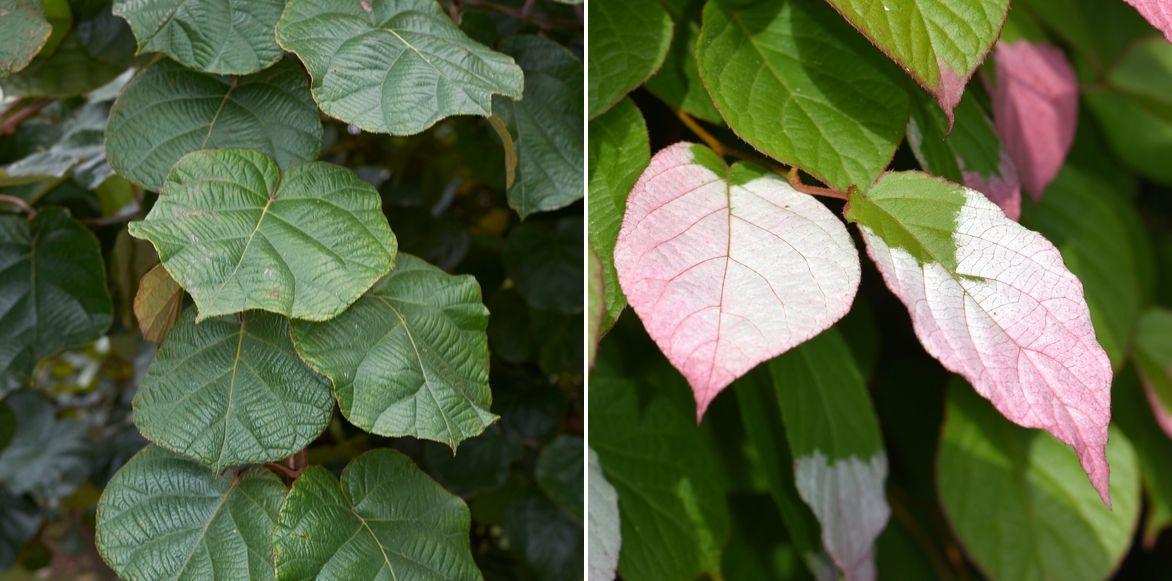
Various foliage: Actinidia deliciosa and Actinidia kolomikta (Ornamental Kiwi)
On this ample foliage, in May-June, after only the fourth or fifth year of cultivation, small flowers bloom either solitary or in groups of three in the axil of the leaves on the previous year’s shoots. These fragrant flowers consist of 5 petals, cream-white or yellowish-white, depending on the variety. But how can one distinguish between male and female kiwi trees?
Most Actinidia species are dioecious, meaning they require the presence of a male plant nearby for pollination by bees. However, new varieties of Actinidia are self-fertile (male and female flowers on the same plant): a single tree is sufficient to produce fruit. The male/female distinction is easily made by looking at the flowers: female flowers measure 3 to 4 cm in diameter, are solitary, and have short stamens surrounding white stigmas, while male flowers are smaller, grouped in cymes of 3 flowers with numerous fertile stamens, very prominent, golden, and powdery.
Only female plants produce fruit. This flowering is followed by the formation of numerous oval summer berries, 3 to 9 cm long, which are the kiwis. The appearance, colour, size, and flesh of the fruits vary from one species or variety to another.
The size of an egg in Actinidia deliciosa and Actinidia chinensis, the fruit does not exceed that of a gooseberry or a large grape in kiwi arguta or Kiwai. The fine skin is fuzzy, covered in short brown hairs in Actinidia deliciosa, while it is so smooth in others (Kiwai) that peeling is unnecessary. While the classic kiwi is well-known for its light brown skin enclosing marbled almond-green flesh, some varieties offer golden fruits (Actinidia chinensis ‘Minkigold’), or even dark red like the Siberian Kiwi ‘Ken’s Red’ or the Kiwi (Actinidia deliciosa) ‘Kiwi Wonder®.’
This juicy pulp, more or less sweet, contains about 1000 small black seeds in its centre. Its tangy flavour resembles that of green apple and is rich in fibre, vitamins C and E, carotene, and minerals such as magnesium and calcium. The taste of the kiwai is closer to that of gooseberries and is sweeter than traditional kiwi.
Contrary to popular belief, the Kiwi is very hardy, able to withstand negative temperatures down to -15°C, but young shoots are sensitive to severe spring frosts. Actinidia arguta, also known as Siberian Kiwi, is probably the hardiest, able to withstand temperatures down to -20°C. The kiwi thrives in full sun or partial shade and prefers cool, rich, light, well-drained, non-calcareous soil. This vigorous and hardy liana can be trained against a wall, a pergola, or climb up a tree.
The name “Kiwi” refers to the endemic bird of New Zealand, whose plumage resembles that of the fruit.
Read also
How to plant a fruit tree?Self-fertile or dioecious species?
Most new varieties of kiwi (or vine-plant) are characterised by being self-fertile (‘Solissimo’, ‘Jenny’, or ‘Solo’): a single young plant is enough to produce fruit. However, some require the presence of a male counterpart nearby to bear fruit. In this case, you must plant 1 male young plant, or you will not have any kiwi. Male young plants are significantly more floriferous than female young plants; they do not produce fruit but pollinate female young plants: one male young plant can pollinate about 5 to 6 female young plants at a distance of 5-6 m.
Discover other Kiwi bush
View all →Available in 0 sizes
Available in 0 sizes
Available in 0 sizes
Available in 1 sizes
Available in 1 sizes
Available in 2 sizes
Available in 1 sizes
Available in 1 sizes
Available in 1 sizes
Available in 1 sizes
Main species and varieties
Chez les kiwis et kiwaï, there are different species, including male pollinator varieties. Some varieties are self-fertile. To make your life easier and ensure optimal fruiting, we offer kiwi duos consisting of a female plant and a pollinator plant, as well as many self-fertile varieties.
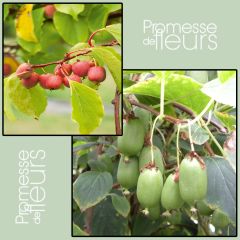
Siberian Kiwi Duo 'Ken's Red' (female) + 'Issai' (pollinator)
- Flowering time July, August
- Height at maturity 5 m
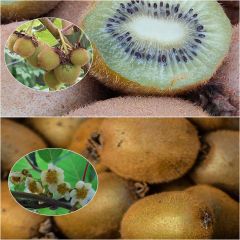
Duo of Female 'Hayward' and Male Pollinator 'Atlas' Kiwi Plants
- Flowering time July, August
- Height at maturity 6 m
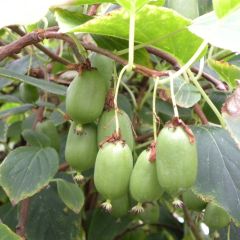
Hardy Kiwi Geneva (self-fertile) - Actinidia arguta
- Flowering time July, August
- Height at maturity 5 m
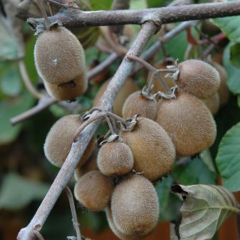
Kiwi Plant Solissimo (self-fertile) - Actinidia chinensis
- Flowering time June, July
- Height at maturity 6 m
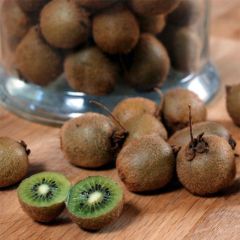
Kiwi Plant Jenny (self-fertile) - Actinidia deliciosa
- Flowering time July, August
- Height at maturity 6 m
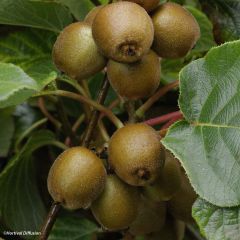
Yellow Kiwi Plant Minkigold (female) - Actinidia chinensis
- Flowering time July, August
- Height at maturity 6 m
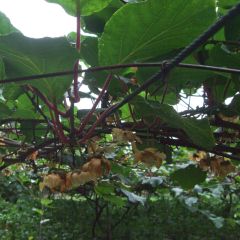
Kiwi Plant Golden Delight (female) - Actinidia chinensis
- Flowering time July
- Height at maturity 5 m
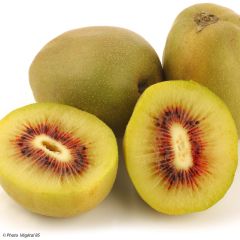
Yellow Kiwi Plant Kiwi Wonder (female) - Actinidia deliciosa
- Flowering time June, July
- Height at maturity 5 m
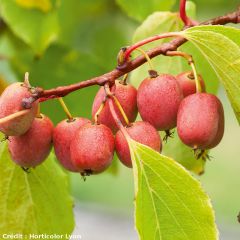
Hardy Kiwi Ken's Red (female) - Actinidia arguta
- Flowering time July, August
- Height at maturity 5 m
Read also
7 superfoods to grow in your gardenPlanting
Where to plant kiwi?
Perfectly hardy, kiwi can withstand temperatures of around -15 °C. However, it is sensitive to late frosts, as the buds freeze at -4 to -5 °C. Provide it with a sheltered spot from cold winds and spring frosts that may scorch its young shoots and damage its flowers. Avoid particularly north or east-facing walls.
Kiwi enjoys sunny but not scorching situations, especially in the south of France. It prefers rich, deep soils with low lime content to prevent chlorosis, well-drained and remaining cool in depth. It dislikes waterlogged and suffocating soils that retain water in winter. It will naturally thrive on a raised bank if your land retains too much water in winter.
Kiwi needs space to establish itself, especially since for non-self-fertile species, you will need two plants (one female plant and its pollinator) for it to bear fruit.
Training kiwi is necessary: plan for a sturdy support of 5 to 6 m in length and 3 m in height for its stems to cling to.
It can be trained on a wall with strong wire, a trellis, a well-exposed pergola, or run between two tree trunks. It naturally finds its place in an orchard.
When to plant?
Ideally, plant kiwi in autumn, from October to November. It is best planted in spring in regions with harsh winters. In temperate zones, our container plants can be installed year-round outside of frost periods.
How to plant?
For non-self-fertile varieties of kiwis and kiwaï, plan to plant at least one male plant for every five female plants, maintaining a planting distance of 2 to 3 metres between plants.
Planting:
- Loosen the soil well to a depth of 80 cm in all directions
- Dig a hole 3 to 5 times wider than the root ball
- Spread a layer of gravel at the bottom of the planting hole
- Plant the root ball, leaving the collar level with the soil
- Fill with a mix of garden soil, sand, and potting soil enriched with a good handful of well-matured compost
- You may also add crushed horn
- Provide a support to help its stems climb
- Firm the soil and water generously, then regularly during the first year after planting
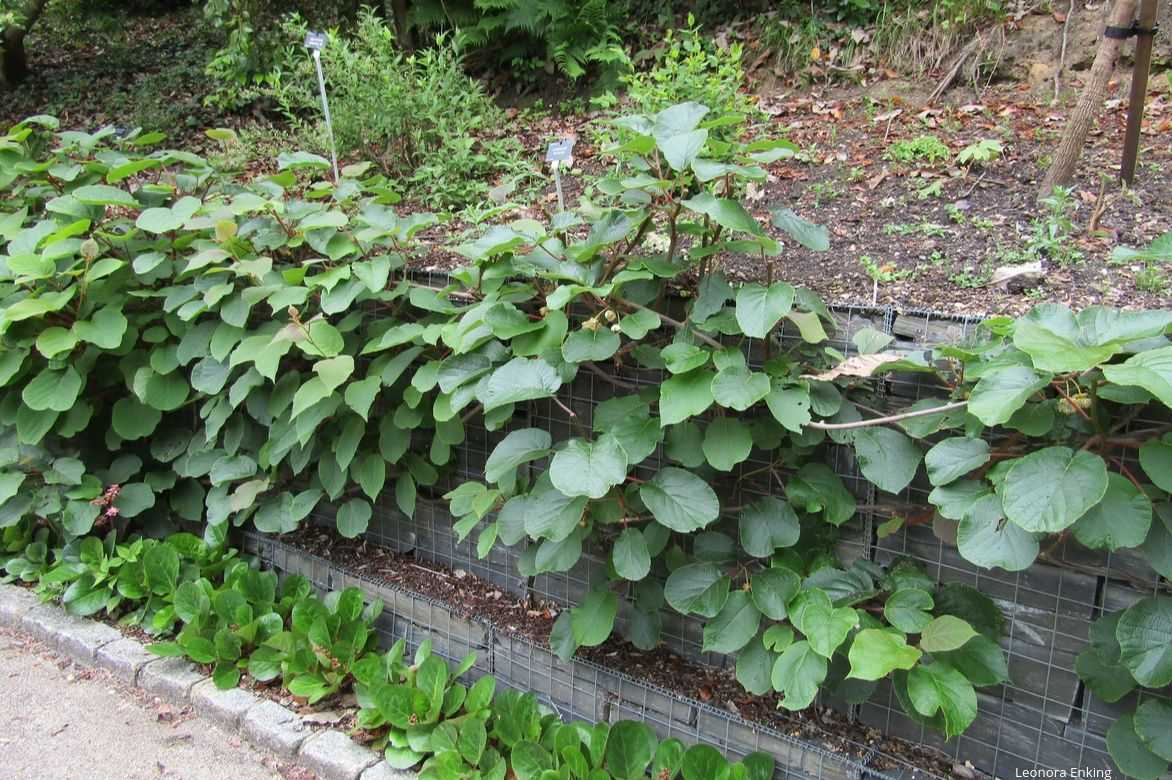
Kiwi trained on a trellis
Maintenance, pruning and care
Kiwi prefers soils that retain a bit of moisture: it needs water. Water regularly in summer and during the first three years. In periods of high heat, water 1 to 2 times a week. Mulch around the base to maintain good moisture. The kiwi requires fertile soil to thrive: each spring, at the time of flowering, apply a special fruit fertiliser and compost in March at the base of the kiwi.
Protect the base with a good layer of straw during the first three winters.
Perform shallow hoeing to keep the base clean and prevent the germination of adventive plants.
Train the liana as it grows.
Pruning Kiwi and Kiwai:
When and how to prune?
Pruning plays a crucial role in the fruiting of the kiwi plant. Kiwis are borne on the shoots of the year, pruning encourages fruiting. It is also a voluble plant that can quickly become invasive. Therefore, pruning is necessary to promote branching and control its growth. Two types of pruning are recommended:
- Winter pruning
In the early years, during winter, from December to mid-February, simply remove any obstructive branches and shorten the secondary branches before the vegetation resumes.
Just after the harvest, each year in October-December, cut back the branches that bore fruit by a quarter: leave 2-3 buds after the last group of harvested fruits.
Shorten the other shoots, leaving 3-4 buds.
Keep a few main branches to form the framework.
- Summer fruiting pruning
-In July, when the fruits are just slightly larger than a cherry:
Remove the too-small fruits, keeping only 4 fruits per group.
Pinch the new shoots to 4 leaves after the last fruit.
Remove the suckers to increase the size of the fruits.
-In August: re-trim the branches pruned in July, leaving only 2 leaves from the regrowth.
- Maintenance pruning
- Every 3 or 4 years, cut back to 3 cm from the main branch the shoots that have lost vigour.
- On mature plants, after 10 years of cultivation, cut the old wood at the base above a shoot.
- On male plants, simply shorten the length of the shoots.
→ Find all our tips: “Pruning Kiwi: when and how to prune an actinidia?” and “training the kiwi.”
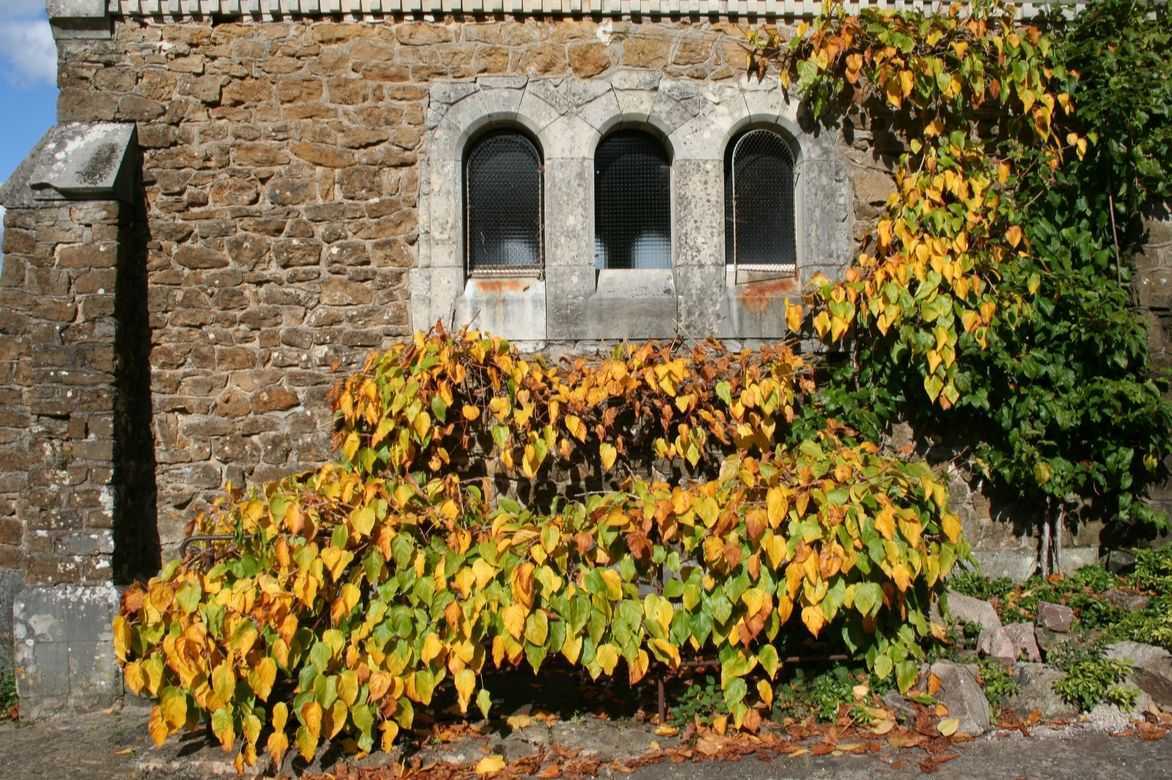
Actinidia arguta in autumn
When and how to harvest kiwis and kiwifruit?
Once your kiwis are planted, remember that you will need to wait about 4 to 5 years before you can make your first fruit harvest.
Depending on the variety type, kiwi harvesting takes place between September and December, just before the frosts. Pick them on dry days. You can harvest them while still green as they continue to ripen after picking. The harvest of Kiwaï occurs from the end of September through October.
A young kiwi plant will produce about 10 kg, then up to 30 to 50 kg of fruit per year after 10 or 12 years of cultivation.
How to store kiwis?
These “vegetable mice” only keep for a few days at room temperature or in the fridge for about fifteen days after harvesting. They can also be stored cool for several months between 2 and 5 °C in a ventilated, dry cellar or storeroom or even frozen.
If you want to speed up their ripening, place the kiwis near apples or bananas.
Benefits and uses of Kiwi
Low in calories (47 kcal per 100 g), kiwi can be enjoyed fresh, simply cut in half or peeled. Good for health, this fruit is a concentrate of vitamins, particularly C (more than oranges!) and E, and is also rich in fibre and trace elements. Its black seeds contain omega 3. The kiwaï is sweeter than the usual kiwi and is also richer in calcium and vitamin C.
It is a fruit with antioxidant properties, protective against cardiovascular diseases.
Once peeled, the tangy and sweet flesh enhances the flavour of desserts such as fresh fruit salads and is suitable for making jams, compotes, tarts, and sweet-savoury dishes.
Diseases and potential pests
Cultivated under good conditions, ‘Actinidia proves to be resilient and not very susceptible to diseases and pests. Rarely diseased, it can, however, be sensitive to bacterial necrosis (pseudomonas syringae and viridiflava) if the soil is too moist: ensure proper soil drainage, avoid wetting the foliage, remove affected parts, carry out clean and precise pruning, and make horsetail decoctions.
In case of overly calcareous soil, chlorosis may occur, causing the foliage to yellow.
Red spider mites also lead to yellowing of the leaves, followed by their drying and dropping. They thrive in warm, dry conditions: do not hesitate to mist the foliage to eliminate them.
→ Learn more about the diseases and pests of kiwi in our article!
Multiplication
The multiplication of kiwi can be done either by cuttings or by layering. Grafting is very reliable but is a technique mainly intended for professionals.
Propagation by cuttings
Multiply the kiwi by propagating semi-woody shoots in summer.
- Take a semi-woody shoot about fifteen centimetres long from the tips of this year’s growth
- Remove the leaves located towards the base of the stem, leaving only two at the tip
- Plant the cutting in a mixture of turf and sand
- Place the cutting in a humid environment at a warm temperature of 25 °C, maintaining a moist atmosphere throughout the winter
- Plant the rooted cutting the following spring
Discover more tips with How to propagate a kiwi? Our tips for success and Successfully propagate your plants
By layering
Its branches are very long, which simplifies layering!
- In spring, lay a flexible shoot in the ground at the base of the tree
- Remove leaves and scrape the bark for 5-10 cm on this part of the stem
- Bury it in a furrow 10 to 15 cm deep, close to the parent plant so it can root
- Cover with potting soil and secure the layer
- Raise the end of the branch and stake it
- When the layer has sufficient roots, you can cut it just below to separate it from the parent plant, then replant it in the ground
Pairing Kiwi
Kiwi can be planted in both orchards and ornamental gardens. It needs to be trained on a support. It adapts perfectly to pergolas and trellises, dresses up walls, or will naturally wrap around trees. Combining both fruit and ornamental qualities, it boasts lush foliage and fruits that hang until the onset of winter.
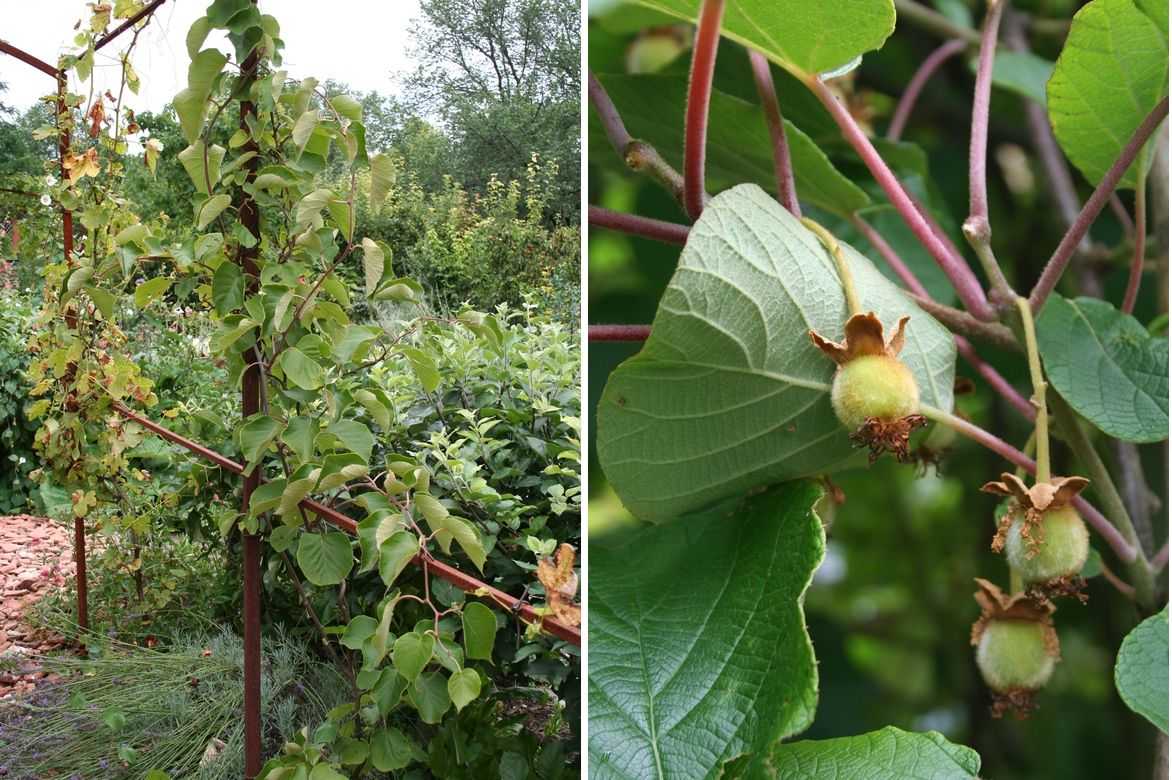
A trained Actinidia on a structure
It pairs well with Schisandra Chinensis, another fruiting and decorative liana that, like the Kiwi, enjoys moist soils and a sunny to semi-shaded exposure, or with a Goji (Lycium barbarum). To create a gourmet trellis throughout the seasons, integrate it with Honeyberries or May Berries.
In an orchard, place it near an Asimina triloba or “Paw Paw”, a small fruit tree with tropical-like appearances, or an Arbutus, also known as the “Strawberry Tree,” with its round fruits resembling strawberries.
Perennial groundcovers like Creeping Bugles and Heucheras will keep its roots cool throughout the summer.
Useful resources
- Curious and gourmet gardeners, discover in our nursery all our original and exotic fruit trees!
- 7 exotic and hardy fruit trees to grow in the garden
- Also check our advice sheet ‘Fruit trees: protect your orchard naturally’
- Find all our other fruit trees in our online nursery.
- 5 climbing fruit plants to plant in the garden
- Our article: Male and female kiwi: how to distinguish them?
- Our article: how to differentiate between kiwi and kiwai?
- Ingrid presents 2 ornamental kiwis to discover
- Article: Fruit trees: the most popular self-fertile varieties
- Article: How to choose the right variety?
- Discover why a kiwi does not produce fruit!
Frequently asked questions
-
My kiwi isn't flowering!
It takes 4 to 5 years of cultivation to see the actinidia flower. Most species of kiwis are dioecious, meaning you need to plant a male plant to see a female plant bear fruit. Ensure this, or you may never see a single fruit appear on your liana! However, there are self-fertile varieties that have both male and female flowers on the same plant, which eliminates the need to plant a second plant to harvest. Another explanation could be that you pruned it too severely: until fruiting, just lightly prune the less vigorous shoots.
- Subscribe!
- Contents
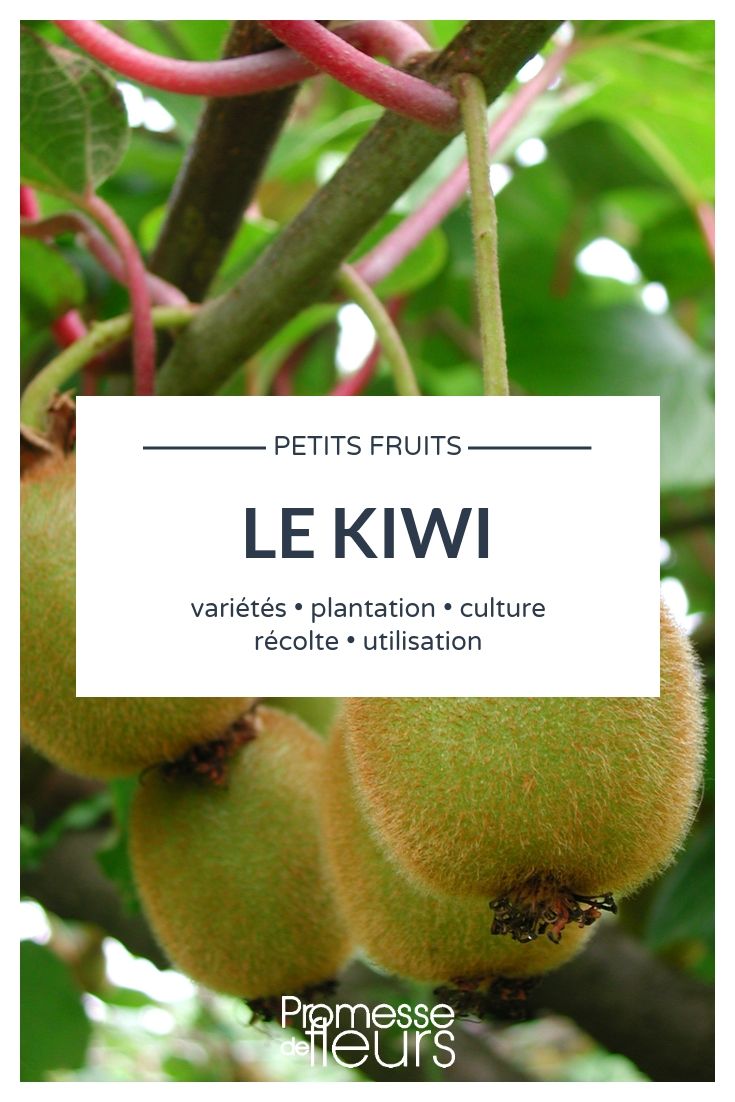































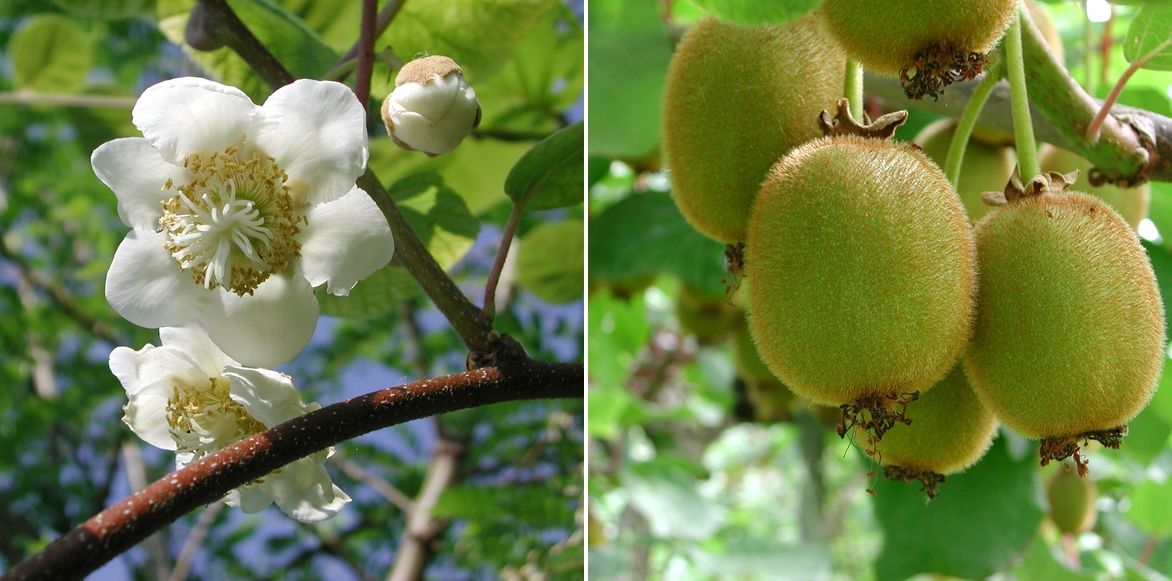
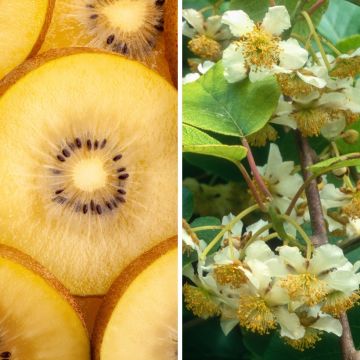
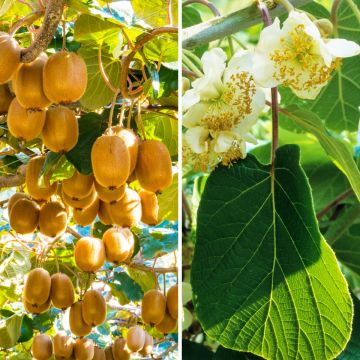



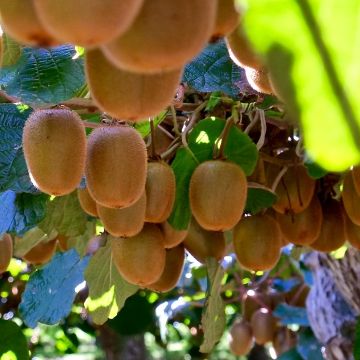




Comments